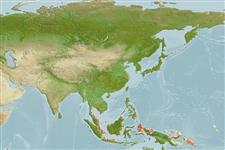>
Blenniiformes (Blennies) >
Blenniidae (Combtooth blennies) > Salariinae
Etymology: Paralticus: Greek, para = near + Latin, altus = nutritious (Ref. 45335).
More on author: Bleeker.
Environment: milieu / climate zone / depth range / distribution range
Ökologie
seewasser riff-verbunden; tiefenbereich 0 - 1 m (Ref. 90102). Tropical; 32°N - 15°S
Western Central Pacific: known only from northeastern Sabah east to western New Guinea at Biak Island and Geelvink [=Sarera or Cenderawasih] Bay.
Size / Gewicht / Alter
Maturity: Lm ? range ? - ? cm
Max length : 16.0 cm TL Männchen/unbestimmt; (Ref. 48636); 10.6 cm SL (female)
Kurzbeschreibung
Morphologie | Morphometrie
Rückenflossenstacheln (insgesamt): 12 - 13; Rückenflossenweichstrahlen (insgesamt): 17-20; Afterflossenstacheln 2; Afterflossenweichstrahlen: 18 - 20. Large bushy tentacles above the eyes and the broad rounded snout (Ref. 48636).
In sheltered bays and lagoons, on rocky reefs and commonly found under jetties on the pylons near the surface (Ref. 48636); also found along semi-exposed rocky shorelines (Ref. 1602). Also found in mangroves and on shoreline reefs. Solitary (Ref. 90102) but also occurs in small groups (Ref. 48636). Oviparous (Ref. 205). Eggs are demersal and adhesive (Ref. 205).
Life cycle and mating behavior
Geschlechtsreife | Fortpflanzung | Ablaichen | Eier | Fecundity | Larven
Oviparous, distinct pairing (Ref. 205).
Springer, V.G. and J.T. Williams, 1994. The Indo-West Pacific blenniid fish genus Istiblennius reappraised: a revision of Istiblennius, Blenniella, and Paralticus, new genus. Smithson. Contrib. Zool. 565:1-193. (Ref. 9962)
IUCN Rote Liste Status (Ref. 130435)
Bedrohung für Menschen
Harmless
Nutzung durch Menschen
Mehr Information
Alter/GrößeWachstumLänge-GewichtLänge-LängeLängenhäufigkeitenMorphometrieMorphologieLarvenLarven Pop.Dyn.RekrutierungDichteBRUVS
ReferenzenAquakulturAquakultur ProfilZuchtlinienGenetikElectrophoresesVererbbarkeitKrankheitenVerarbeitungNutrientsMass conversion
PartnerBilderStamps, Coins Misc.LauteCiguateraGeschwindigkeitSchwimmstilKiemenoberflächeOtolithsGehirngrößeSehfähigkeit
Tools
Zusatzinformationen
Download XML
Internet Quellen
Estimates based on models
Preferred temperature (Ref.
123201): 28.7 - 29.2, mean 28.9 °C (based on 154 cells).
Phylogenetic diversity index (Ref.
82804): PD
50 = 1.0000 [Uniqueness, from 0.5 = low to 2.0 = high].
Bayesian length-weight: a=0.01072 (0.00480 - 0.02393), b=3.01 (2.82 - 3.20), in cm total length, based on LWR estimates for this (Sub)family-body shape (Ref.
93245).
Widerstandsfähigkeit (Ref.
120179): hoch, Verdopplung der Population dauert weniger als 15 Monate. (Preliminary K or Fecundity.).
Fishing Vulnerability (Ref.
59153): Low vulnerability (10 of 100).
